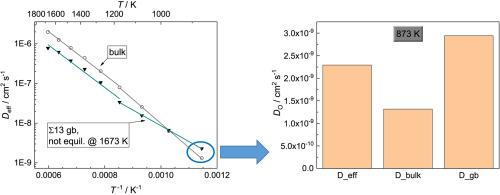Modelling of oxygen diffusion in perovskite-type neodymium strontium ferrite Nd0.3Sr0.7FeO3-δ by application of molecular dynamics
IF 3.5
3区 化学
Q2 CHEMISTRY, INORGANIC & NUCLEAR
引用次数: 0
Abstract
The diffusion of oxygen in Nd0.3Sr0.7FeO3-δ (NSF37) with δ = 0.35 (space group: ) was modelled in the temperature range from 2000 to 873 K by means of molecular dynamics (MD). The Nd and Sr atoms on the A-site sublattice as well as the oxygen vacancies on the oxygen sublattice were distributed randomly. The MD simulations yielded the trajectories as well as mean square displacements of oxygen atoms, resulting in vacancy self-diffusion coefficients which showed a non-Arrhenius type temperature dependence. The activation energy increased from 0.9 to 1.2 eV with decreasing temperature. The radial pair distribution functions, computed for Nd – O and Sr – O correlations, indicated the formation of defect interactions (preferential residence of vacancies in the vicinity of Sr) which might give rise to the variation of the activation energy. Moreover, the effect of symmetrical Σ13 (320) grain boundaries on the oxygen transport in NSF37 was investigated in detail. In particular, the effective oxygen self-diffusion coefficient (comprising both bulk and grain boundary regions) was determined as a function of temperature ranging from 1673 to 873 K. When the interfaces were equilibrated properly at 1673 K, leading to amorphous interfacial regions, the grain boundaries were clearly blocking for the oxygen transport. If, however, the equilibration at 1673 K was omitted (largely preventing the amorphization of the grain boundaries), fast grain boundary diffusion could be observed at low temperatures. At 873 K the grain boundary diffusion coefficient exceeded the bulk diffusivity by a factor of 2–3.

氧在钙钛矿型钕锶铁氧体Nd0.3Sr0.7FeO3-δ中扩散的分子动力学模拟
用分子动力学(MD)方法模拟了氧在2000 ~ 873 K温度范围内δ = 0.35的Nd0.3Sr0.7FeO3-δ (NSF37)(空间群:Pm3 m)中的扩散。a位亚晶格上的Nd和Sr原子以及氧亚晶格上的氧空位是随机分布的。MD模拟得到了氧原子的轨迹和均方位移,得到了空位自扩散系数,该系数表现出非arrhenius型的温度依赖关系。随着温度的降低,活化能从0.9 eV增加到1.2 eV。计算Nd - O和Sr - O相关的径向对分布函数表明,缺陷相互作用的形成(空位优先居住在Sr附近)可能导致活化能的变化。此外,还研究了对称Σ13(320)晶界对NSF37中氧输运的影响。特别是,有效氧自扩散系数(包括体区和晶界区)是温度范围为1673 ~ 873 K的函数。当界面在1673 K时达到适当的平衡,形成非晶界区,晶界明显阻碍了氧的输运。然而,如果忽略1673 K时的平衡(很大程度上阻止了晶界的非晶化),则可以在低温下观察到快速的晶界扩散。在873 K时,晶界扩散系数超过体扩散系数2-3倍。
本文章由计算机程序翻译,如有差异,请以英文原文为准。
求助全文
约1分钟内获得全文
求助全文
来源期刊

Journal of Solid State Chemistry
化学-无机化学与核化学
CiteScore
6.00
自引率
9.10%
发文量
848
审稿时长
25 days
期刊介绍:
Covering major developments in the field of solid state chemistry and related areas such as ceramics and amorphous materials, the Journal of Solid State Chemistry features studies of chemical, structural, thermodynamic, electronic, magnetic, and optical properties and processes in solids.
 求助内容:
求助内容: 应助结果提醒方式:
应助结果提醒方式:


